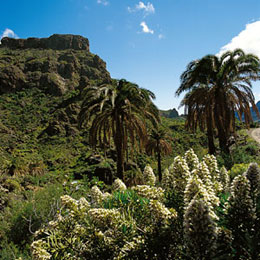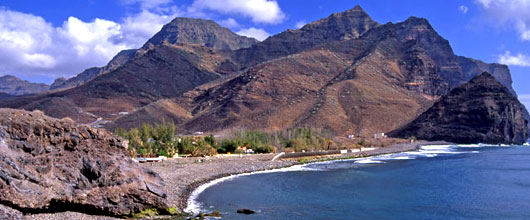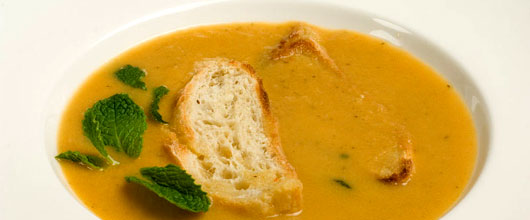A tour through the municipality of La Aldea de San Nicolás gives the visitor a chance to appreciate the popular Canarian architecture in the old quarter of the town such as the houses of stone and mud from the 17th and 18th centuries, and the houses with balconies from the 18th century. Examples of these are the Casa del Balcón, the first house in the town centre, Casas Blancas and the Casa del Corredor, which is in the Tocodomán quarter.


The Museo Vivo (live museum) is very popular. It is a live representation of Canarian culture and traditions. Threshing carried out with animals, the making of bread in a traditional stone oven, the milking of goats, the tasting of milk and gofio or the making of cheese are some of the representations that can be seen.
The legacy of the aborigines is also very significant in La Aldea. At the Archaeological Site of Los Caserones, a rich collection of pintaderas (seals) and mud and stone idols was found and is preserved today in the Museo Canario in Las Palmas. You can visit the Túmulo Funerario(burial mound) of the Lomo de Caserones (La Aldea beach).
A visit to the four flour wind and water mills is recommended, as is a visit to the lime and pitch ovens and to the still for distilling rum which was in use between 1936 and 1958 at the Playa de la Aldea (La Aldea beach).

The natural surroundings of the municipality are exceptional and there is a range of routes and paths, along which the scenic beauty of the west of Gran Canaria can be appreciated. Ninety per cent of the area is protected.
The Parque Rural del Roque Nublo (Rural Park of the Roque Nublo) is the largest protected area on Gran Canaria, and spreads over the municipalities of Tejeda, La Aldea de San Nicolás, Mogán, San Bartolomé de Tirajana, Artenara, San Mateo, Valleseco and Moya. Within this area is the symbolic Roque Nublo, a monolith which represents the island of Gran Canaria.
The Parque Natural de Tamadaba (Nature Park of Tamadaba) stretches into the municipalities of Agaete, Artenara and La Aldea de San Nicolás and is one of the oldest geological formations on the island.
The Reserva Natural Integral de Inagua is a pine forest which covers the old massif of the centre-west of the island, and has the most spectacular views. It belongs to the municipalities of La Aldea, Mogán and Tejeda and is a Zona de Protección Especial de Aves (Specially Protected Bird Area).
Finally, the Special Nature Reserve of Güi-Güi is of great scenic value. It is covered with endemic species of vegetation and has its own special marine bird fauna.
Along the 33 kilometre coastline of La Aldea de San Nicolás stony beaches alternate with small coves, large caves, sandy beaches etc. The majority of the beaches are not very frequented and are preserved almost intact in an unspoilt landscape.

http://turismo2.grancanaria.com/
The most significant are the Playa de la Aldea, the most frequented as it is situated in the town itself, the beaches of Tasarte and Tasartico and most especially the beaches of Güi-Güi, which are of black sand and whose surroundings are of great natural beauty.
Nowadays a new generation of painters, sculptors, photographers, writers, musicians and potters has sprung up and this has meant that the municipality is acquiring a rich cultural and craft heritage.
Craftsmanship in La Aldea is widely represented through numerous families who combine work on the land with a small craft production for themselves and for the island market. Therefore, most of the crafts fall within the category of basket and palm ware for the making of hats, baskets, matting etc.
The visitor may go to the Aula Etnográfica where many local craftsmen gather to do their work. There you can buy locally made food products or crafts. You can also buy crafts in Cactualdea.
The typical food of La Aldea is both delicious and varied. The best is fresh fish and shellfish, meat, caldo de pescado(a kind of fish stew), boiled mojo made from electric eels, vegetable stews etc. Special mention must be given to a dish invented in the municipality, namely Ropa Vieja de Pulpo (a typical dish of chick peas and octopus instead of chicken).

There are plenty of tropical fruits such as Canary bananas, papayas, mangoes, guava and avocadoes. Homemade jams of tomatoes, papaya, mango and prickly pears are delicious as are the local sweets based on these fruits, as well as cakes and mantecados (traditional sweets made mainly from lard).
Local cheeses are of very high quality and have been awarded prizes for their excellent taste.
La Aldea de San Nicolás: Download Tourist Brochure | Map | Podcast
Accommodation: La Aldea de San Nicolás
Wandering Pier Gran Canaria takes you on a walk to discover Azulejos en Inagua.